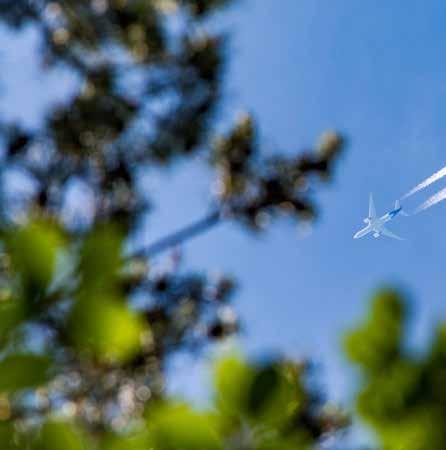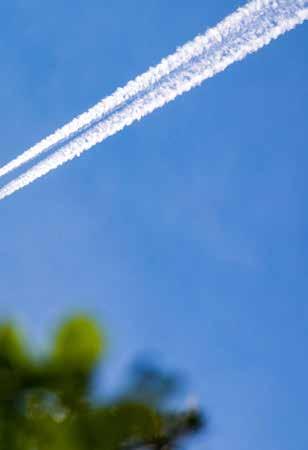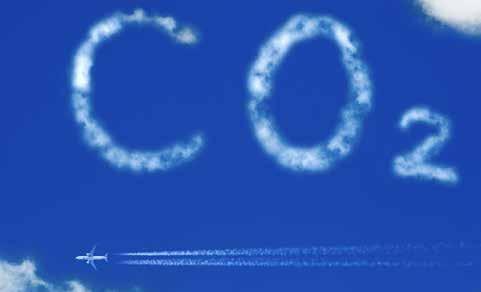
4 minute read
AFRAA’s position on environment
1. Introduction
Sustainability has become a major subject of concern within the global aviation industry. Leaders are focusing on reducing the environmental impact through technological improvement. Global warming, environmental degradation, climate change and depletion of resources are becoming widespread. In response, aviation is conducting business with the long term goal of reducing aviation’s net CO2 emissions to half of what they were in 2005, by 2050. Aviation aims to do this by focusing on technology improvements, operational efficiencies, infrastructure development and sustainable aviation fuels (SAF).
Advertisement
Air Transport contributes to 2% of human-made CO2 emissions. Though air traffic doubles every 15 to 20 years, the Aviation sector has developed a strategy to attain and maintain carbon neutral growth by 2020. Africa aviation share in the global CO2 reduction goals and AFRAA have been working with stakeholders in coordinating the African response. This policy paper summarises AFRAA’s position relating to the environment in Africa.
2. Africa status vis-à-vis the environment
In Africa, though the industry is growing, airlines’ share of global traffic has stagnated at around 2% for a very long time. In real terms, African airlines’ market share for intercontinental traffic has shrunk from 60% some 40-50 years ago to just about 20% in recent times and still shrinking. African aviation contribution to the global aviation emission of 2% CO2 is very negligible. However, as the potential for aviation growth on the continent is enormous, to the sector is proactively working on and promoting measures and programs to protect the environment.
3. AFRAA regional approach for environment
Climate change effects are more visible across the Continent. The southwards expansion of the Sahara, the changing rainfall patterns, severe flooding and droughts are indications of global warming and environmental degradation.
Therefore, AFRAA strategy is to drive global aviation environmental initiatives with local targets and deliverables to ensure a sustainable industry. In partnership with other stakeholders, AFRAA 5 pillar approach to a improving the environment from the aviation perspective are as follows:
Pillar 1: Continuous fuel efficiency improvement through new technology
Encouraging airlines to invest in new technology and aircraft that are more efficient and emit less CO2. Striving to meet more stringent environmental SARPS and operations procedures aircraft will burn less fuel and consequently lessening their environmental footprint.
Pillar 2: Alternative fuel
Promote the adoption of the use of bio-fuel as one way to reduce the dependence on jet A1 from crude oil. In Africa, SAA pioneered the use of blend-in bio-fuel in a demonstration operations between Johannesburg and Cape Town. With Africa’s vast arable land, it could grow much needed by-products for bio-fuels.
Africa and African airlines should prepare for the use of bio-fuel as technology mature in the medium term.
Pillar 3: Implementation of Fuel Conservation Initiatives in Operations
Focused on maintenance, ground, and flight operations, AFRAA urges members to implement relevant fuel conservation initiatives to burn less fuel in operations, to emit less CO2 while reducing their fuel bills.
AFRAA is working closely with member airlines towards the implementation of fuel conservation programs in operations.
Flight Procedure Program (A-FPP) to assist the African States in designing the procedures at very competitive costs. These PBN procedures support the performance of safe Continuous Climb Operations (CCOs) and Continuous Descend Operations (CDOs) along Standard Instrument Departure (SID) and Standard Arrival Routes (STARs) while improving fuel efficiency in the TMAs.
It is AFRAA’s view that Air Navigation Service Providers (ANSPs) should provide flexible routings in clusters of airspaces with entry and exit points, taking advantage of the low-density flights across the Continent’s huge area. Flight operations along flexible routings exploit high altitude winds, reduce flight times, decrease fuel burnt, and limit CO2 emission significantly.
AFRAA urges airlines, ANSPs, and states to build on gained experience in the Atlantic Ocean Random Routing Area (AORRA) to extent flexible routing operations gradually in the continental airspace.
Pillar 5: CORSIA
Pillar 4:
Air Navigation
Infrastructure Stakeholders agreed to set as a priority the implementation of PerformanceBased Navigation (PBN) procedures in terminal areas (TMAs) at African airports. To support the deployment of PBN in TMAs, ICAO established the African
In 2016, the ICAO Assembly adopted the Carbon Offsetting and Reduction Scheme for International Aviation (CORSIA), to stabilise net CO2 emissions from international aviation from 2021. ICAO has now agreed that 2019 emissions will be used as the baseline for net CO2 emissions from international aviation. AFRAA actively participated in regional coordinated position of African States for CORSIA.
CORSIA has applied to international aviation since 1 January 2019 when all airlines were required to report their CO2 emissions on an annual basis. From 1 January 2021, international flights will become subject to offsetting obligations.

Author: AFRAA
The CORSIA voluntary phase for states is from 2021 until 2026. As of July 2021, 106 states (including 17 from Africa) representing 77% of international aviation activity have committed to the voluntary phase.
From 2027 onwards, CORSIA comes into force and will be mandatory. AFRAA is encouraging more African States to sign up for the voluntary phase so as to test their monitoring and reporting efficiency and accuracy. This phase gives opportunity for participating states to make corrections and adjustments in readiness for the mandatory phase beginning 2027.
Industry capacity building, advocacy and sensitisation events by AFRAA and partners will continue aimed at assisting particularly airlines to better understand their role and obligations.
4. Conclusion
Climate change trends are a wake-up call for all economic sectors to take action and reduce human-induced CO2 emissions worldwide. Though air transport emission share is only 2% of the world’s CO2, the aviation sector has developed several initiatives to reach and maintain carbonneutral growth by 2020 and reduce aviation’s net CO2 emissions to half of what they were in 2005, by 2050, while air traffic increases.


AFRAA believes that African aviation will contribute to protecting better the environment; it requires that aviation stakeholders continue coordinated efforts in line with the five pillars:
• Continuous Fuel Efficiency Improvement through New Technology;
• Alternative Fuel;
• Implementation of Fuel Conservation Initiatives in Operations;
• Air Navigation Infrastructure and;
• Carbon Offsetting and Reduction Scheme for International Aviation (CORSIA).








